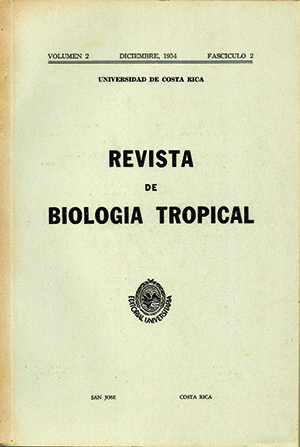Abstract
A complete chronological review is presented of the literature on Trypanosoma rangeli Tejera 1920 and on the new neotropical trypanosomiasis. Critical nosomanotes are made, evaluating the contributions of the several investigators In Venezuela, Colombia, and Guatemala, where the human cases have been reported.
Regarding trypanosomes similar in certain aspects to T. rangeli and isolat ed from some animals in French Guiana, T. cebus Floch and Abonnenc is noted as presenting in fact no fundamental differences with T. rangeli, notwithstanding that its study was incomplete, for which reason it is considered a synonym of the latter species. The hypothesis is offered that the natural vertebrate host of T. rangeli is an American monkey.
As to the flagellate reported once from Chile in triatomine insects, it can not be held to be T. rangeli; and the human case reported from Argentina, in the author, opinion, should not be taken in consideration because it was not properly documented, leaving doubts in its interpretation.
The matter of T. ariarii Groot, Renjifo and Uribe 1951 is discussed in detail, concluding that there is not enough evidence to consider it a separate species, and that the differences reported by the authors were merely apparent - a conclusion arrived at by GROOT himself in a later publication.
Stress is laid on the inability of T. lewisi, which has been reported once in man, to evolve in the intestine of Rhodnius prolixus, thus eliminating the hypothesis of its identity with T. rangeli.
T. rangeli appears, from the literature, to be non pathogenic on man; human cases are characterised by the persistence and small number of the trypanosomes in the blood stream.
Experimental data are presented, obtained with Groot's "ariarii" strain and with Venezuelan T. rangeli. New-born rats and mice were inoculated with "ariarii", stock; only one of each showed infection in fresh material. A loss of virulence of the trypanosome is suggested, due to its cultivation in vitro.
Several experiments were carried out with the Venezeulan T. rangeli. Some specimens of R. prolixus were inoculated in the general cavity, and the evolution of the flagellate was observed in several stages, the protozoan appearing to behave as in artificial culture media. Crithidial forms found within the phagocytes of the hemolymph are not considered viable.
Further reproduction of the protozoan was observed in the salivary glands of inoculated insects dissected some time after infection had become established, as GROOT et al. had succeeded in showing for the "ariarii" strain in Colombia.
New hemolymphatic infections are thought to follow from these glandular forms. Following Wigglesworth's opinion, the writer finds a close relationship between the hematinic pigment stored in the salivary glands of R. prolixus and the evolution of T. rangeli in therm.
Lastly, mice, rats, Cebus monkeys, dogs, and guinea pigs were inoculated with insect hemolymph and with cultures of T. rangeli. No infection was demonstrated either by examination of fresh material (mice and rats) or by that method and xenodiagnosis (monkeys, dogs, guinea pigs) in any of the test animals.
Once again the difficulty is evidenced of obtaining blood forms of this trypanosome. The age of the cultures (the number of transfers) and the medium used are listed as fundamental factors contributing to failure of the inoculations, besides those inherent to the biology and physiology of certain Trypanosomidae.






